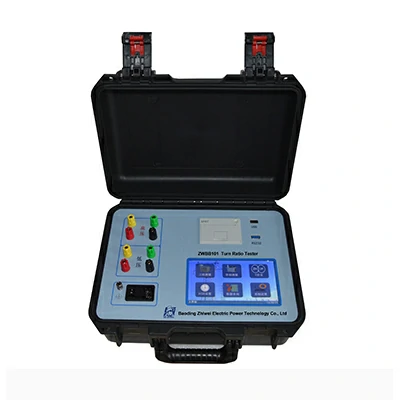Transformer Turns Ratio (TTR) meters are used to measure the turns ratio of transformers, which is essential for assessing their performance and identifying any faults or discrepancies.
There are differences between AC and DC TTR meters in terms of their operating principles, applications, and capabilities:
- Operating Principle:
- AC TTR Meter: AC TTR meters operate based on the principle of mutual induction. They apply an alternating current (AC) signal to the primary winding of the transformer and measure the resulting voltage induced in the secondary winding. The turns ratio is calculated by comparing the primary and secondary voltages.
- DC TTR Meter: DC TTR meters, on the other hand, operate based on the principle of magnetic flux linkage. They apply a direct current (DC) signal to the primary winding and measure the resulting magnetic flux. The induced voltage in the secondary winding is then measured to determine the turns ratio.
- Frequency:
- AC TTR Meter: AC TTR meters typically operate at line frequency (50 Hz or 60 Hz) or at variable frequencies for specialized applications. The frequency of the AC signal affects the magnetic properties of the transformer core and can influence the accuracy of the turns ratio measurement.
- DC TTR Meter: DC TTR meters operate at a constant frequency, which is determined by the direct current applied to the transformer winding. Unlike AC TTR meters, they do not rely on variations in frequency for measurement.
- Accuracy:
- AC TTR Meter: AC TTR meters are generally more accurate for measuring turns ratio, especially for transformers designed to operate with AC signals. They account for factors such as core saturation and winding impedance, transformer turns ratio meter which can affect the measurement accuracy.
- DC TTR Meter: DC TTR meters may offer higher accuracy for specific types of transformers or applications. They are less affected by core saturation and can provide accurate measurements even for transformers with nonlinear magnetic characteristics.
- Applications:
- AC TTR Meter: AC TTR meters are commonly used for testing power transformers, distribution transformers, and other transformers designed for AC operation. They are suitable for routine maintenance, diagnostics, and quality assurance testing.
- DC TTR Meter: DC TTR meters are often used for specialized applications such as testing transformers for HVDC (high-voltage direct current) transmission systems, where DC operation is predominant. They may also be used for testing transformers with specific design requirements or where AC testing is not feasible.
- Cost and Complexity:
- AC TTR Meter: AC TTR meters are widely available and generally more cost-effective compared to DC TTR meters. They are also simpler to operate and interpret results, making them suitable for a wide range of testing applications.
- DC TTR Meter: DC TTR meters are more specialized and may be more expensive than AC TTR meters. They require additional considerations for safety and calibration due to the use of direct current, which can increase complexity.
In summary, AC and DC TTR meters differ in their operating principles, frequency, accuracy, applications, and cost. While AC TTR meters are more common and versatile, DC TTR meters are suitable for specific applications requiring DC testing or where higher accuracy is desired. Choosing the appropriate type of TTR meter depends on the specific requirements of the transformer being tested and the intended application.

